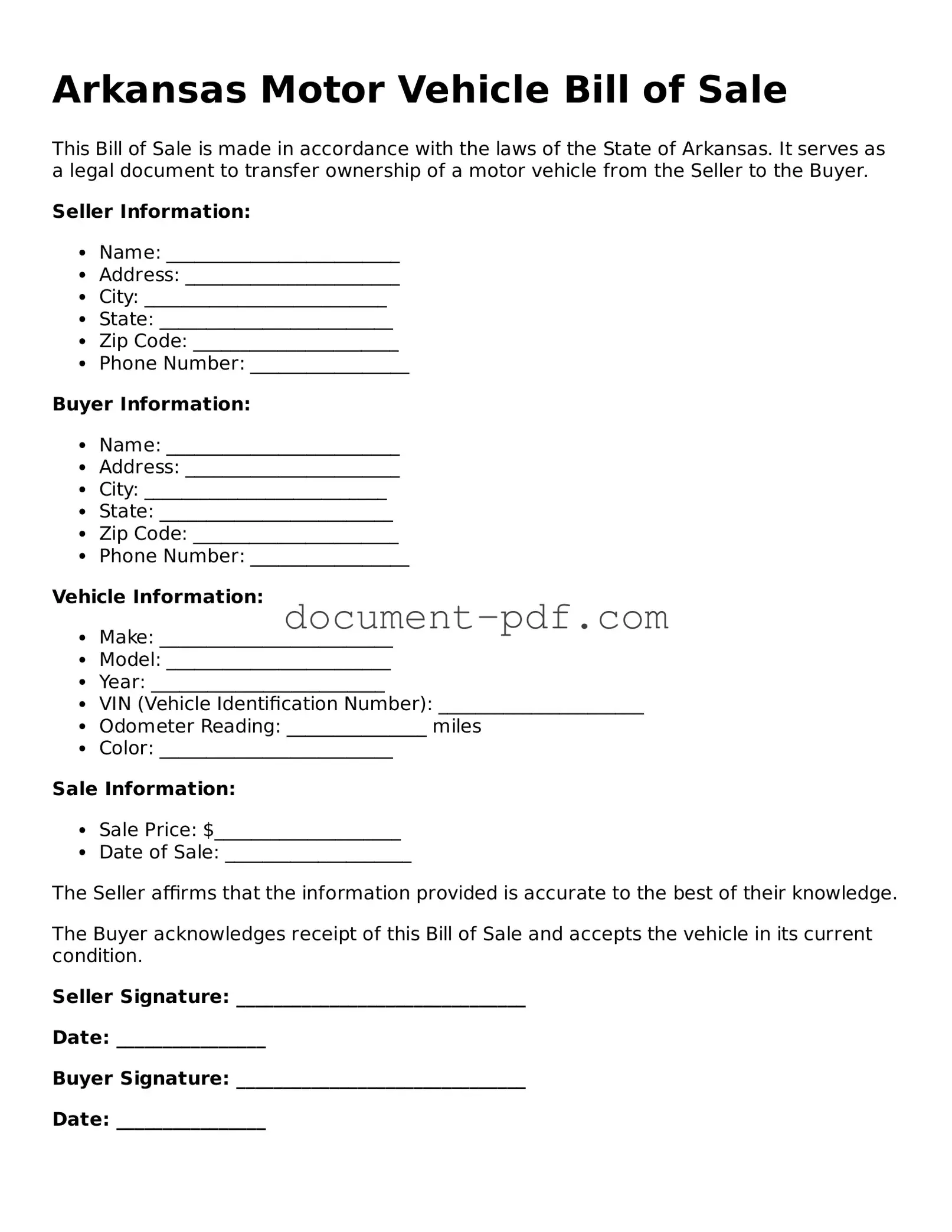The Arkansas Motor Vehicle Bill of Sale form shares similarities with the general Bill of Sale document used across various states. A Bill of Sale serves as a legal record of the transfer of ownership for personal property. It outlines the details of the transaction, including the buyer and seller's names, the item description, and the sale price. This document provides proof of purchase and can be essential for tax purposes or to establish ownership in the future.
Another document akin to the Arkansas Motor Vehicle Bill of Sale is the Vehicle Title. The title serves as the official record of vehicle ownership. When a vehicle is sold, the title must be signed over to the new owner. This document includes vital information such as the vehicle identification number (VIN), make, model, and year. Like the Bill of Sale, the title is critical for registering the vehicle in the new owner's name.
The odometer disclosure statement is also similar to the Arkansas Motor Vehicle Bill of Sale. This document is required when transferring ownership of a vehicle and verifies the mileage at the time of sale. It helps prevent fraud by ensuring that the seller accurately reports the vehicle's mileage. This statement is often included in the Bill of Sale or as a separate document, depending on state requirements.
A purchase agreement is another document that closely resembles the Arkansas Motor Vehicle Bill of Sale. This agreement outlines the terms and conditions of the sale, including the purchase price, payment method, and any contingencies. While the Bill of Sale serves as proof of the transaction, the purchase agreement details the obligations of both parties leading up to the sale.
In many states, a vehicle registration application parallels the Arkansas Motor Vehicle Bill of Sale. This application is submitted to the state’s motor vehicle department to officially register the vehicle in the new owner's name. It often requires information found on the Bill of Sale, such as the sale price and the seller's information, making it a critical document in the ownership transfer process.
The lien release form is another document that shares similarities with the Arkansas Motor Vehicle Bill of Sale. If a vehicle was financed, the lender would hold a lien on it until the loan is paid off. A lien release form is necessary to show that the loan has been satisfied and that the borrower is free to sell the vehicle. This document is important for the new owner to ensure they are receiving clear title to the vehicle.
The warranty deed is a document used in real estate transactions, but it shares some characteristics with the Arkansas Motor Vehicle Bill of Sale. Both documents serve to transfer ownership and establish the rights of the new owner. While the warranty deed pertains to real property, the principles of ownership transfer and legal acknowledgment apply similarly in both cases.
The seller’s disclosure statement is often used in real estate but can also be relevant for vehicle sales. This document informs the buyer of any known issues with the vehicle, such as prior accidents or mechanical problems. Transparency in the sale process protects both the seller and the buyer, similar to the information provided in a Bill of Sale.
If you are interested in safeguarding your interests, consider reviewing the essential guidelines for a Hold Harmless Agreement tailored to your requirements. For more information, visit the comprehensive Hold Harmless Agreement resource.
Finally, the sales receipt is another document that resembles the Arkansas Motor Vehicle Bill of Sale. A sales receipt provides a record of the transaction and includes details such as the date of sale, the item sold, and the amount paid. While it may not contain all the legal elements of a Bill of Sale, it serves as proof of the transaction and can be useful for record-keeping purposes.
